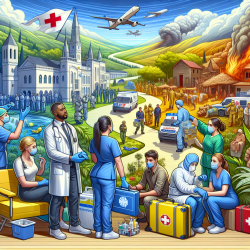Introduction
Natural disasters pose a significant threat to health facilities, especially in regions like South East Europe. The research article "Health Facilities Safety in Natural Disasters: Experiences and Challenges from South East Europe" highlights the importance of safeguarding these critical infrastructures. As practitioners, understanding these challenges and implementing the outcomes of such research can significantly enhance our skills and preparedness.
Key Findings from the Research
The study focuses on the disaster management approaches in Croatia and Serbia, emphasizing the need for robust technological and legislative systems for the safety and protection of health facilities. Here are some key takeaways:
- Integrated Risk Management: Transition from response-oriented to integrated risk management, including prevention, preparedness, response, and recovery.
- Regional Collaboration: Encourages collaboration among neighboring countries to share experiences and resources.
- Environmental Security: Implementation of environmental security principles in public health policies to enhance disaster management.
Improving Practitioner Skills
Practitioners can leverage these findings to improve their skills in several ways:
- Continuous Education: Engage in training programs that focus on disaster preparedness and management. This includes understanding the Safe Hospitals Checklist components like location, structural safety, and functional safety.
- Policy Implementation: Advocate for and participate in the development of policies that integrate disaster risk reduction into health sector planning.
- Networking and Collaboration: Build networks with regional and international organizations to share knowledge and best practices.
Encouraging Further Research
The research underscores the importance of further studies in disaster management, particularly in regions vulnerable to natural disasters. Practitioners are encouraged to explore areas such as:
- Vulnerability Assessment: Develop methodologies for assessing the vulnerability of health facilities.
- Impact of Climate Change: Investigate the long-term effects of climate change on health infrastructure.
- Technological Advancements: Explore the role of technology in enhancing disaster preparedness and response.
Conclusion
Protecting health facilities from natural disasters is crucial for ensuring the continuity of medical services. By implementing the research findings and engaging in continuous learning and collaboration, practitioners can significantly enhance their skills and contribute to more resilient health systems.
To read the original research paper, please follow this link: Health Facilities Safety in Natural Disasters: Experiences and Challenges from South East Europe.










